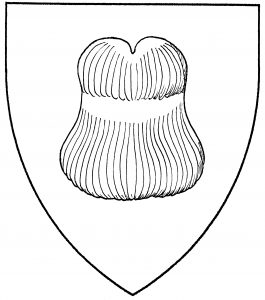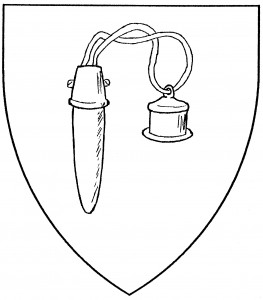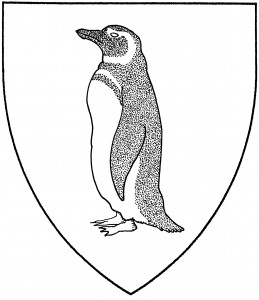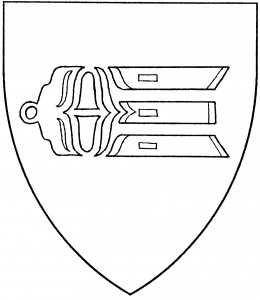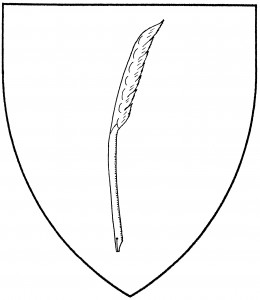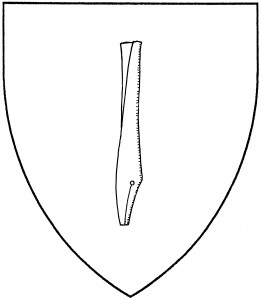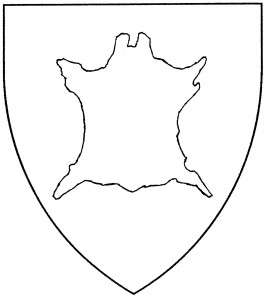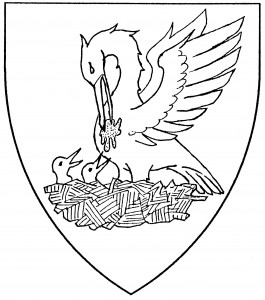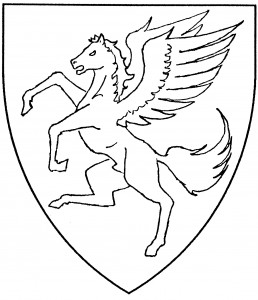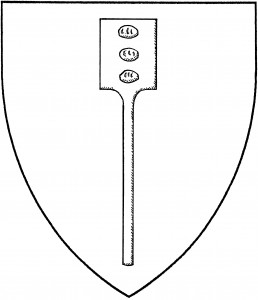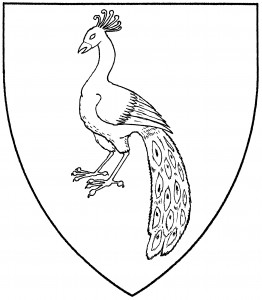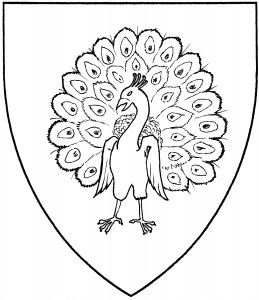Carlos Blanco el Barbero bears as a badge: Or, in pale a perruque gules and a sinister hand azure.
Moyai-Nidun bears as a badge: Gules, a perruque and on a chief argent a grenade sable.
Archives
Penner and inkhorn
The penner and inkhorn is considered a single charge: a cylindrical container for pens, connected by cords to an ink bottle. It’s found in the armory borne by the Worshipful Company of Scriveners, 1530 (though not confirmed until 1634) [Bromley & Child 217]. For related charges, see penbox.
The College of Scribes of Caid bears: A penner and inkhorn argent.
Salomea Imhof bears: Purpure, three penners and inkhorns argent.
Samthann ingen Garbáin bears: Argent, three penners and inkhorns azure.
Penguin
The penguin is a flightless sea bird of the Southern Hemisphere, short and squat, with wings strongly resembling flippers. Breeds of penguin were known in period, described by Sir Francis Drake in 1578 [OED s.v. penguin], but none appear in period armory. The use of a penguin in Society armory is considered a step from period practice.
The penguin is statant and close by Society default, as in the illustration. The “proper” penguin is defined to be sable, bellied and marked argent, in roughly equal proportions; it should be colored as a breed of penguin known to period Europeans (such as the Magellanic penguin, illustrated).
Meghan Pengwyn of Wynterwood bears: Gules, an Emperor penguin close to sinister proper.
Josselyn ferch Rhys bears: Argent, four Emperor penguins statant affronty, one, two and one proper, all within a bordure azure.
Isabella Gase atte Cloude bears: Or, in fess three penguins statant affronty, heads facing to dexter, sable bellied argent.
Penbox
A penbox is a container for calligraphic supplies. In Society heraldry, it’s drawn in a highly abstract manner, as found in Middle Eastern armory of the 14th Century and later [Mayer 45]; it is usually blazoned a “Saracenic” or “Arabic” penbox for that reason. As a charge from outside Europe, the Arabic penbox carries a step from period practice. For related charges, see penner and inkhorn.
Sayf al-Qamar Tarik ibn Abdul bears: Sable, a fess between a scimitar fesswise inverted and an Arabic penbox fesswise argent.
Tahira of Carolingia bears: Sable, on a fess argent an Arabic penbox azure.
Pen
A pen is a tool for writing or drawing with ink. The most common form of pen in heraldry is the “quill pen”, sometimes misleadingly (and wrongly) blazoned simply a “quill”; it’s found in the canting arms of Coupens c.1312 [ANA2 514]. The quill pen is the default form of pen for Society use; the illustration is taken from Bossewell, 1572 [III.4v]. But other types of pen are also found in Society armory, most notably the “reed pen” or “calamus”; this is simply a tubular reed with a split point at one end. It’s similar to the pens found in the arms of Hales, c.1520 [Woodcock & Robinson pl.13].
Pens are palewise by default, with points to base. For related charges, see feather. See also quill of yarn.
The Chronicler bears: Per pale sable and argent, two quills conjoined in pile counterchanged, a chief gules.
Elizabeth Bellclerke bears: Azure, in fess three quill pens bendwise sinister argent.
Catharine Hawkwod da Barbiano bears: Or, six quill pens azure.
Thomas Megatherium of Castle Leviathan bears: Per pale purpure and sable, a reed pen palewise Or surmounted by an anvil argent.
Pelt; Hide
A pelt is the skin of an animal, removed from its body and laid flat by default. In period armory, the usual pelt seems to be of a squirrel or other small animal, as found in the Zurich Roll, c.1340 [406]. In Society armory, the most common pelt is blazoned a “hide”, and is considered a cowhide (as illustrated). Other beasts’ hides are blazoned explicitly. In each case, the part of the hide that attached to the beast’s head is to chief by default. For related charges, see fleece.
Vuong Manh bears: Gules, on a hide Or a roundel enflamed and depicted as a t’ai ch’i vert.
John FitzWilliam bears: Sable, a hide argent.
Sveinn Raudskeggr bears: Gules, on a bear’s hide argent a bear’s pawprint purpure.
Pelican
The pelican is a marine bird, which in medieval legend would revive its dead young with blood from its own breast. Its most common posture is thus blazoned a “pelican in its piety”: wings addorsed, piercing its breast with its beak to feed its young. (The posture is also sometimes blazoned a “pelican vulning itself”, particularly if no hatchlings are depicted.)
Period depictions of this bird do not show it as found in nature, with a baggy-bottomed beak, but with a long slender beak resembling that of a stork, and with ruffled feathers.
The pelican was used in the canting arms of Pelham as early as 1386 [DBA2 177]. In Society armory, the pelican is reserved to the Order of Peerage of the same name, and its members.
The Order of the Pelican bears: A pelican in its piety.
Dorio of the Oaks bears: Azure, a chevron ployé cotised and in base a pelican in its piety argent.
Pegasus
The pegasus is a winged monster, a horse with an eagle’s wings grafted to its shoulders. Its association with the Muses of Greek myth makes it a popular charge with poets. As an heraldic charge, it dates from at least 1544, in the arms of Cavalere or Cavalier [Dennys 157].
The pegasus does not seem to have a default posture, so the posture must be blazoned. By Society rulings, a rampant pegasus (as shown in the illustration) may also be blazoned “segreant”, like the dragon, griffin, and other four-legged monsters with wings. For related charges, see horse.
Frideger Leopo Sturmreiter bears: Argent, two pegasi combattant azure.
Wentliana Bengrek bears: Purpure, three pegasi rampant to sinister argent.
Aislynn Haldana Cadell bears: Or, a pegasus segreant vert.
Peel, baker’s
A baker’s peel, or baker’s paddle, is a long-handled wooden spatula, used for placing bread into (and taking it out of) ovens. It is therefore often shown with manchets, or breadloaves, on the paddle. The baker’s peel is a period charge, found in the canting arms (Italian pala) of Palazolo, mid-15th C. [Triv 281]. Its default orientation is palewise, paddle to chief [Parker 450]. See also oar, spade.
Giacomo Fornerigo bears: Or, a baker’s peel bendwise sinister sable charged with three loaves of bread Or sustained by an arm embowed issuant from sinister proper vested sable, a chief rayonny gules.
Rowena Longstrider bears: Purpure, a cooking pot between a mascle of four baker’s paddles, heads to chief argent.
Tomas de Courcy bears as a badge: On a baker’s peel vert three plates.
Peacock
The peacock is a colorful bird, the medieval archetype of vanity. Its wings are close by default; it is much more important to blazon his tail. By default, the peacock’s tail extends behind him, close and sweeping the ground, as in the arms of the Princes of Wiedt, 1605 [Siebmacher 16]. At one point in the Society’s history, this posture was blazoned as “pavonated [to base]”; but the term is no longer used, the posture being recognized as the default for the bird.
Perhaps the best-known posture for the peacock is “in his pride”: affronty (or turned slightly), head facing dexter, and the tail expanded to display its colors. The peacock in his pride is found in period armory, in the arms of Halle, c.1340 [Zurich 476].
A peacock’s “proper” coloration is a blend of blue and green, which will conflict with either tincture. For related charges, see firebird, simurgh.
The Baron of One Thousand Eyes bears: Or, a peacock in his pride, head to sinister, within a laurel wreath azure.
Eleanor de la Mare bears: Erminois, a peacock proper within a bordure wavy azure.
Eleonora di Gerardo bears: Vert, three peacocks in their pride argent.
Ceallach mac Domhnaill bears: Argent, three peacocks in their pride proper.
